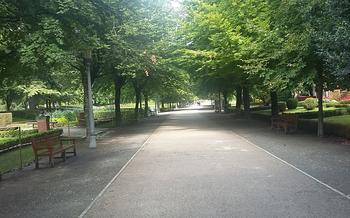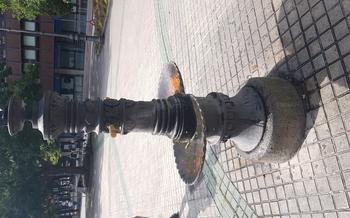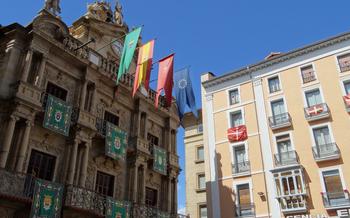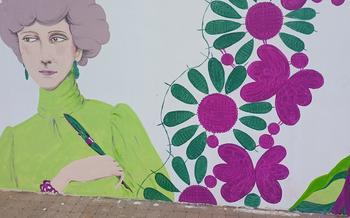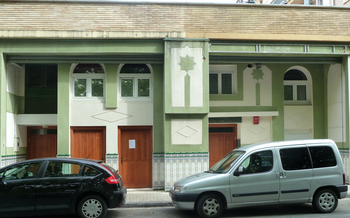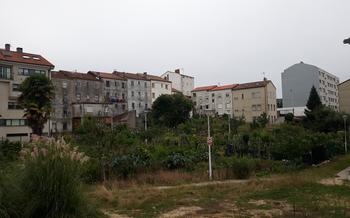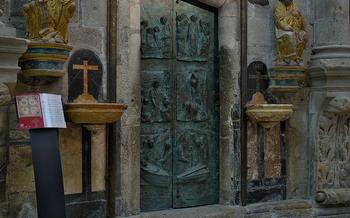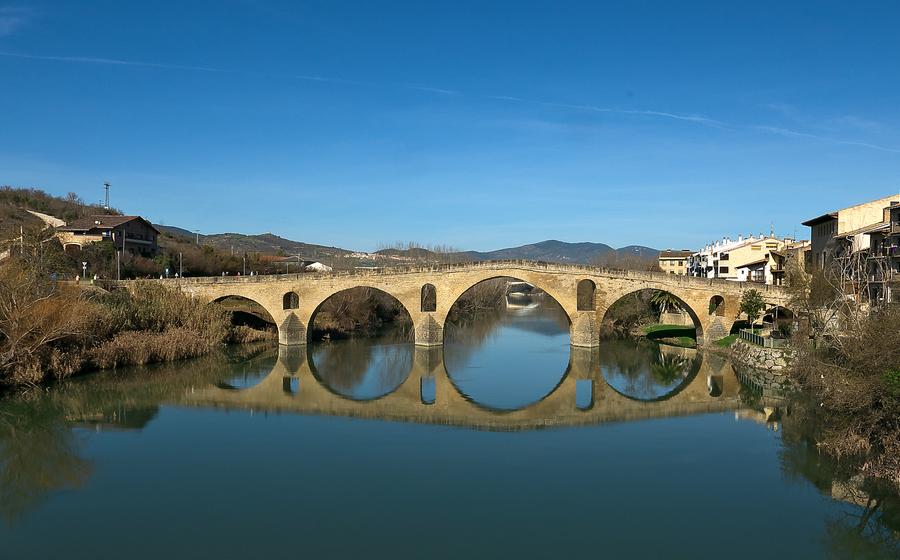
Puente la Reina
- Hospital de la Misericordia
- Museo de la Fundación Miguel Echauri
- Palacio del Condestable
- Plaza del Consejo
- Monumento al Encierro
- Plaza de Toros
- Museo Taurino
- Catedral de Santa María la Real
- Navarrese Cuisine
- Pamplona's Festivals
- Insider Tip: Discover the Hidden Charm of Pamplona
Hospital de la Misericordia
The Hospital de la Misericordia, founded in the 12th century, stands as a testament to Pamplona's profound connection to the Camino de Santiago. This medieval hospital, with its impressive Gothic architecture, has played a pivotal role in providing care and shelter to countless pilgrims traversing the ancient pilgrimage route. Its grand facade, adorned with intricate carvings and a majestic clock tower, hints at the rich history it holds within its walls.
Throughout the centuries, the Hospital de la Misericordia has undergone various transformations and expansions, reflecting the changing needs of pilgrims and the evolving healthcare landscape. Its dedication to providing compassionate care has remained unwavering, earning it a reputation as a sanctuary for weary travelers seeking respite and healing.
A visit to the Hospital de la Misericordia is a journey through time, where the whispers of history intertwine with the present. Its beautifully preserved interiors, featuring vaulted ceilings, stone archways, and intricate tilework, offer a glimpse into the hospital's rich past. Within its walls, visitors can explore exhibits showcasing medical instruments, ancient remedies, and personal accounts of pilgrims who found solace and rejuvenation within these sacred halls.
Engaging with local historians or guides during a visit to the Hospital de la Misericordia provides an invaluable opportunity to delve deeper into the hospital's legacy. These passionate storytellers bring to life the tales of pilgrims who sought refuge within its walls, sharing anecdotes of resilience, devotion, and the transformative power of human compassion.
Whether you're a history buff, a pilgrim seeking inspiration, or simply curious about Pamplona's cultural heritage, the Hospital de la Misericordia offers a unique and enriching experience. It's a place where the past and present converge, reminding us of the enduring spirit of hospitality and the profound impact of caring for those in need.
Museo de la Fundación Miguel Echauri
The Museo de la Fundación Miguel Echauri, nestled in the heart of Pamplona, stands as a, sculptures, and artifacts, all meticulously curated from the private collection of Miguel Echauri, a renowned local artist and collector.
The museum's exhibits offer a fascinating journey through the history of art, showcasing works from renowned Spanish and international artists, including El Greco, Goya, and Picasso. Visitors can admire the vibrant colors and intricate brushstrokes of these masters, as well as delve into the diverse styles and techniques that have shaped the art world over the centuries.
Beyond its permanent collection, the museum also hosts temporary exhibitions, shedding light on specific periods, movements, or themes in art history. These exhibitions provide a platform for emerging artists and allow the museum to engage with contemporary artistic practices.
A visit to the Museo de la Fundación Miguel Echauri is not just an encounter with art but also a journey into the cultural and historical tapestry of Pamplona. The museum's dedication to preserving and showcasing the region's artistic heritage makes it a must-visit destination for art enthusiasts and anyone seeking a deeper understanding of the city's vibrant cultural landscape.
Palacio del Condestable
The Palacio del Condestable stands as the 16th century, this magnificent Renaissance-style palace served as the residence of the Condestable de Navarra, a high-ranking official in the kingdom. Its imposing façade, adorned with intricate carvings and a grand entrance, hints at the grandeur that awaits within.
Over the centuries, the Palacio del Condestable has played a pivotal role in shaping the destiny of Pamplona. It witnessed the signing of significant treaties, hosted lavish banquets, and served as a meeting place for the kingdom's elite. Its walls reverberate with tales of political intrigue, power struggles, and the unfolding history of Navarre.
Today, the Palacio del Condestable has been transformed into a vibrant cultural center, welcoming visitors to explore its splendid halls and immerse themselves in the arts. It houses a diverse range of exhibitions, from contemporary art displays to historical retrospectives, showcasing the rich cultural heritage of Pamplona and the broader region.
Attending an event or exhibition at the Palacio del Condestable is an enriching experience that transports visitors back in time. The palace's elegant architecture, coupled with the vibrant energy of cultural expression, creates a captivating atmosphere that lingers long after the visit. It is a place where history, art, and culture converge, offering a glimpse into the soul of Pamplona and its enduring legacy.
Plaza del Consejo
The Plaza del Consejo, located in the heart of Pamplona's old town, holds a significant place in the city's history. Surrounded by elegant buildings, this charming square was once the center of political and administrative power in Pamplona. The most striking feature of the plaza is the 17th-century Town Hall, an impressive Baroque building with intricate carvings and a majestic clock tower.
The square's historical significance is palpable. In the Middle Ages, it served as a marketplace and a gathering place for the city's residents. It was also here that public announcements were made, and justice was administered. Today, the Plaza del Consejo maintains its lively atmosphere, with outdoor cafes and restaurants lining its perimeter, inviting visitors to soak in the ambiance while enjoying a leisurely meal or a refreshing drink.
Throughout the year, the plaza hosts a variety of events and celebrations. During the annual San Fermín festival, it transforms into a vibrant hub of activity, with concerts, traditional dances, and lively street performances taking place. The square's unique charm and rich history make it a must-visit destination for anyone exploring Pamplona's cultural heritage and vibrant urban life.
Monumento al Encierro
The Monumento al Encier Pamplona and a powerful tribute to the city's most famous tradition. Situated on the edge of the old town, the monument is a bronze sculpture that captures the essence and adrenaline of the encierro, an event that draws thousands of participants and spectators each year.
The monument portrays the frenzied rush of the bulls and runners, with their expressions of fear, excitement, and determination etched into the bronze figures. The sculptures seem to burst out of the pavement, creating a sense of movement and chaos that mirrors the actual running of the bulls. The monument also features a plaque that commemorates the victims who have lost their lives during the encierro, a somber reminder of the risks involved in this dangerous tradition.
The Monumento al Encierro is a powerful representation of Pamplona's cultural heritage and its enduring fascination with the Running of the Bulls. It serves as a reminder of the city's unique identity and the deep connection between its people and this controversial yet iconic event.
My personal thoughts on the tradition and its portrayal in the monument are complex. While I appreciate the cultural significance of the encierro and the artistry of the monument, I also recognize the ethical concerns surrounding the use of animals in such events. The monument serves as a poignant reminder of the risks involved, and it prompts us to reflect on the broader implications of this controversial tradition.
Plaza de Toros
The Plaza de Toros in Pamplona is a historic bullring that stands as a testament to the deep-rooted tradition of bullfighting in Spain. Completed in 1922, this impressive structure has witnessed countless bullfights, becoming an iconic landmark in the city's landscape. Its neo-Mudejar architectural style, characterized by intricate brickwork and horseshoe arches, adds to its grandeur.
Bullfighting, a controversial yet integral part of Spanish culture, has been practiced in Pamplona for centuries. The bullring provides a stage for matadors to showcase their skills and bravery as they face off against formidable bulls. The atmosphere during a bullfight is electric, with spectators cheering, gasping, and expressing a range of emotions.
In recent years, bullfighting has faced increasing scrutiny and opposition due to concerns about animal welfare. Animal rights activists have campaigned to ban the practice, arguing that it is cruel and unnecessary. The debate over bullfighting continues to divide public opinion, with supporters defending it as a cultural tradition and a symbol of national identity.
Despite the controversy, the Plaza de Toros remains an important part of Pamplona's cultural heritage. It is a venue for bullfights, concerts, and other events, attracting both tourists and locals. Whether you are a fan of bullfighting or not, the Plaza de Toros is a must-visit destination to understand the significance of this tradition in Spanish culture.
Museo Taurino
Step into the fascinating world of bullfighting at the Museo Taurino, located in the heart of Pamplona. This museum pays homage to the history, traditions, and cultural significance of bullfighting in Spain. Through a captivating display of artifacts, memorabilia, and interactive exhibits, visitors gain an immersive insight into the art and spectacle of bullfighting.
From vintage posters and bullfighting suits to bullfighting equipment and photographs of legendary matadors, the museum's collection offers a glimpse into the rich heritage of this controversial yet deeply ingrained tradition. Learn about the origins of bullfighting, the techniques and strategies employed by matadors, and the breeding and selection of fighting bulls.
One of the highlights of the museum is the Hall of Fame, which honors the most renowned bullfighters in history. Here, visitors can admire the portraits, trophies, and personal belongings of these legendary figures, gaining a deeper understanding of their impact on the sport.
Whether you are a passionate aficionado or simply curious about this controversial tradition, the Museo Taurino provides a thought-provoking and educational experience. It offers a unique perspective on the cultural significance of bullfighting in Spain, allowing visitors to explore the history, artistry, and controversies surrounding this polarizing spectacle.
Catedral de Santa María la Real
The Catedral de Santa María la Real, the heart of Pamplona. Its imposing façade, adorned with intricate carvings and delicate pinnacles, beckons visitors to step into a realm of sacred beauty.
As you cross the threshold, the vast interior unfolds before you, a symphony of light and space. Soaring columns support intricate vaults, creating a sense of awe and reverence. The stained-glass windows bathe the sanctuary in a kaleidoscope of colors, casting a mystical glow on the ornate altars and statues.
The cathedral holds a wealth of treasures, each with its own story to tell. The alabaster carvings of the choir stalls, depicting scenes from the Bible, are a masterpiece of artistry. The intricately carved wooden doors, adorned with intricate biblical scenes, invite contemplation and wonder.
Beyond its architectural splendor, the cathedral holds deep religious significance. For centuries, pilgrims have flocked to this sacred space, seeking solace, guidance, and a connection to the divine. The Camino de Santiago, the ancient pilgrimage route that winds its way across Europe, finds its culmination here, as weary travelers find respite and renewal within the cathedral's hallowed walls.
Whether you are a pilgrim seeking spiritual fulfillment or a traveler marveling at architectural wonders, the Catedral de Santa María la Real offers an unforgettable experience that will leave an indelible mark on your soul.
Navarrese Cuisine
Pamplona, the vibrant capital of Navarre, boasts a rich culinary tradition deeply rooted in its history and geography. The region's unique location, nestled between the Pyrenees mountains and the Ebro river valley, has shaped a diverse and flavorful cuisine that showcases the bounty of local ingredients.
Navarrese cuisine is renowned for its use of fresh, seasonal produce, meats, and cheeses. One of the must-try dishes is asparagus from Navarra, known for its tender texture and delicate flavor. The region's stews, such as calderete, are hearty and comforting, often featuring lamb or beef simmered with vegetables in a rich broth.
For a taste of traditional Navarrese cooking, visit one of the many family-run restaurants or "sidrerías" in Pamplona. These cozy establishments serve up classic dishes like migas, a savory breadcrumb dish with chorizo and eggs, and ajoarriero, a flavorful codfish and potato stew.
Pamplona's vibrant market scene is a great place to discover local specialties. The Mercado de Santo Domingo is a bustling hub where vendors sell fresh produce, meats, cheeses, and other regional delicacies. Sample some of the local Idiazabal cheese, made from sheep's milk, or try the piquillo peppers, known for their sweet and smoky flavor.
When in Pamplona, be sure to indulge in the region's delicious pastries. The pastel vasco, a traditional Basque cake filled with custard or fruit, is a local favorite. For a sweet treat, try the canutillos de Pamplona, crispy pastry shells filled with a creamy custard filling.
Pamplona's culinary scene is a testament to the region's rich history and diverse cultural influences. Whether you're sampling traditional dishes at a local restaurant, exploring the vibrant market scene, or indulging in sweet treats, you'll find that the flavors of Navarre are sure to tantalize your taste buds.
Pamplona's Festivals
Pamplona is renowned for its vibrant and diverse festivals, which showcase the city's rich cultural heritage and traditions. The most famous of these is the San Fermín Festival, held annually from July 6th to 14th. This festival is known worldwide for its iconic Running of the Bulls, where daring participants run alongside a herd of bulls through the city streets. Beyond the bulls, the festival offers a lively atmosphere with processions, concerts, street performances, and traditional Basque sports competitions.
Another highlight is the Pamplona Jazz Festival, held in July, which features renowned national and international jazz musicians in various venues across the city. The Hemingway Festival, also held in July, celebrates the life and work of the renowned author Ernest Hemingway, who spent significant time in Pamplona and immortalized the city in his novel "The Sun Also Rises."
For those interested in classical music, the Pamplona Symphony Orchestra offers a series of concerts throughout the year, showcasing a diverse repertoire of classical and contemporary pieces. The city also hosts the Pamplona International Film Festival in October, which screens a selection of national and international films and documentaries, accompanied by discussions, workshops, and special events.
These festivals provide a unique opportunity to immerse oneself in Pamplona's vibrant culture, experience the local traditions, and create lasting memories. Whether you're a music enthusiast, a film buff, or simply looking for an unforgettable fiesta, Pamplona's festivals offer something for everyone.
Insider Tip: Discover the Hidden Charm of Pamplona
Beyond the well-trodden tourist paths, Pamplona reveals a treasure trove of hidden gems waiting to be discovered. For an authentic glimpse into the city's soul, venture off the beaten track and explore the lesser-known corners of this vibrant city.
One such gem is the Iglesia de San Nicolás, a charming 12th-century church tucked away in the heart of the old town. Step inside to admire its beautiful Romanesque architecture, intricate frescoes, and peaceful atmosphere.
For a taste of local life, head to the Mercado de Santo Domingo, a bustling market where vendors sell fresh produce, artisanal cheeses, and traditional Navarrese delicacies. Engage with the friendly locals, sample the local flavors, and soak up the vibrant atmosphere.
If you're seeking tranquility, escape to the Parque de Yamaguchi, a serene Japanese garden located on the outskirts of Pamplona. Stroll through its tranquil paths, admire the meticulously manicured gardens, and find a peaceful spot to relax and reflect.
For a unique culinary experience, seek out the Mesón del Caballo Blanco, a traditional Navarrese restaurant that has been serving hearty local dishes since the 15th century. Savor the flavors of classic Navarrese cuisine in a rustic and convivial setting.
To delve deeper into the city's history, visit the Archivo General de Navarra, which houses a vast collection of historical documents and artifacts that shed light on Pamplona's rich past. Explore the archives and uncover the hidden stories that have shaped this remarkable city.
